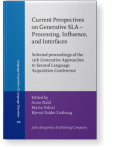Chapter 4
Second language acquisition of English plurals by Chinese learners
Previous research supported the proposal that multiplicity inferences (i.e., the more than one
interpretation) associated with English plural morphology are scalar implicatures (Tieu et al.,
2014). The current study extends the research to second language (L2) acquisition by testing Chinese-speaking learners of
English. Using a Truth Value Judgment Task (TVJT) adapted from Tieu et al. (2014), we
compared the interpretations of English bare plurals among Chinese adult learners and native English speakers. Results indicate that
the interpretive pattern of Chinese learners closely aligns with that of the English controls’. This supports the universality of
scalar implicatures in L2 and does not provide direct evidence for L1 transfer through morpheme mapping from English plural morpheme
-s to Chinese plural morpheme -men.
Article outline
- 1.Introduction
- 2.Plurality, scalar implicature, and L1 transfer
- 2.1English bare plurals and the scalar implicature approach
- 2.2Adult L2 acquisition of scalar implicature
- 2.3Plurality in Chinese and L1 transfer through morpheme-to-morpheme mapping
- 2.3.1Men plurals
- 2.3.2Bare nouns
- 3.Research question and hypotheses
- 4.Experiment
- 4.1Participants
- 4.2Task design and procedure
- 5.Results and discussion
- 6.Conclusion
-
Notes
-
References
This content is being prepared for publication; it may be subject to changes.
